Related Research Articles

In Finnish mythology, the Sampo, sometimes known as Sammas or Kirjokansi, was a magical artifact of indeterminate type constructed by Ilmarinen that brought riches and good fortune to its holder. When the Sampo was stolen, it is said that Ilmarinen's homeland fell upon hard times and he sent an expedition to retrieve it, but in the ensuing battle it was smashed and lost at sea.
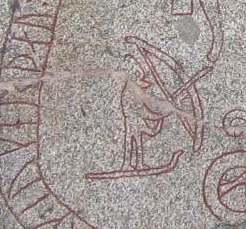
In early Germanic paganism, *Wulþuz ("glory") appears to have been an important concept, perhaps personified as a god, or an epithet of an important god; it is continued in Old Norse tradition as Ullr, a god associated with archery.
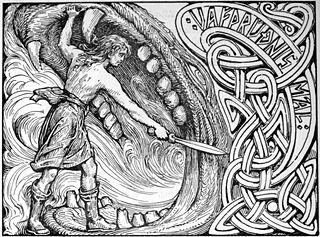
In Norse mythology, Víðarr is a god among the Æsir associated with vengeance. Víðarr is described as the son of Odin and the jötunn Gríðr, and is foretold to avenge his father's death by killing the wolf Fenrir at Ragnarök, a conflict which he is described as surviving. Víðarr is attested in the Poetic Edda, compiled in the 13th century from earlier traditional sources, the Prose Edda, written in the 13th century by Snorri Sturluson, and is interpreted as depicted with Fenrir on the Gosforth Cross. A number of theories surround the figure, including theories around potential ritual silence and a Proto-Indo-European basis.

The Æsir are the gods of the principal pantheon in Norse religion. They include Odin, Frigg, Höðr, Thor, Baldr and Týr. The second Norse pantheon is the Vanir. In Norse mythology, the two pantheons wage war against each other, resulting in a unified pantheon. Unlike the Old English word god, Æsir was never adopted into Christian use.

In Norse mythology, the Vanir are a group of gods associated with health, fertility, wisdom, and the ability to see the future. The Vanir are one of two groups of gods and are the namesake of the location Vanaheimr. After the Æsir–Vanir War, the Vanir became a subgroup of the Æsir. Subsequently, members of the Vanir are sometimes also referred to as members of the Æsir.
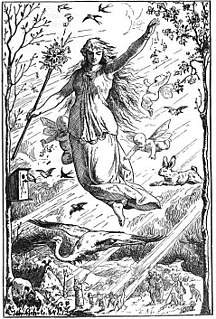
Ēostre is a West Germanic spring goddess. By way of the Germanic month bearing her name, she is the namesake of the festival of Easter in some languages. Ēostre is attested solely by Bede in his 8th-century work The Reckoning of Time, where Bede states that during Ēosturmōnaþ, pagan Anglo-Saxons had held feasts in Ēostre's honour, but that this tradition had died out by his time, replaced by the Christian Paschal month, a celebration of the resurrection of Jesus.

The world egg, cosmic egg or mundane egg is a mythological motif found in the cosmogonies of many cultures that is present in proto-Indo-European culture and other cultures and civilizations. Typically, the world egg is a beginning of some sort, and the universe or some primordial being comes into existence by "hatching" from the egg, sometimes lain on the primordial waters of the Earth.
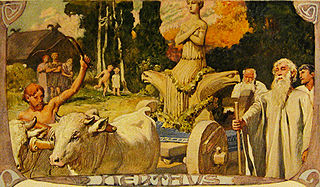
Germanic mythology consists of the body of myths native to the Germanic peoples. The category includes Norse mythology, Anglo-Saxon mythology, and Continental Germanic mythology. It was a key element of Germanic paganism. These stories establish the creation and creature myths that permeated Northern European cultures. They are concerned with the deities, mythical creatures, places and customs that shaped the early and proceeding Germanic peoples.

Proto-Indo-European mythology is the body of myths and deities associated with the Proto-Indo-Europeans, the hypothetical speakers of the reconstructed Proto-Indo-European language. Although the mythological motifs are not directly attested – since Proto-Indo-European speakers lived in prehistoric societies – scholars of comparative mythology have reconstructed details from inherited similarities found among Indo-European languages, based on the assumption that parts of the Proto-Indo-Europeans' original belief systems survived in the daughter traditions.
Mannus, according to the Roman writer Tacitus, was a figure in the creation myths of the Germanic tribes. Tacitus is the only source of these myths.
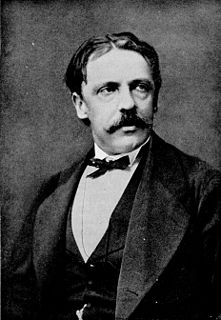
Abraham Viktor Rydberg was a Swedish writer and a member of the Swedish Academy, 1877–1895. "Primarily a classical idealist", Viktor Rydberg has been described as "Sweden's last Romantic" and by 1859 was "generally regarded in the first rank of Swedish novelists."
Comparative mythology is the comparison of myths from different cultures in an attempt to identify shared themes and characteristics. Comparative mythology has served a variety of academic purposes. For example, scholars have used the relationships between different myths to trace the development of religions and cultures, to propose common origins for myths from different cultures, and to support various psychological theories.

The Merseburg charms or Merseburg incantations are two medieval magic spells, charms or incantations, written in Old High German. They are the only known examples of Germanic pagan belief preserved in the language. They were discovered in 1841 by Georg Waitz, who found them in a theological manuscript from Fulda, written in the 9th century, although there remains some speculation about the date of the charms themselves. The manuscript is stored in the library of the cathedral chapter of Merseburg, hence the name.
The Norse mythology, preserved in such ancient Icelandic texts as the Poetic Edda, the Prose Edda, and other lays and sagas, was little known outside Scandinavia until the 19th century. With the widespread publication of Norse myths and legends at this time, references to the Norse gods and heroes spread into European literary culture, especially in Scandinavia, Germany, and Britain. In the later 20th century, references to Norse mythology became common in science fiction and fantasy literature, role-playing games, and eventually other cultural products such as Japanese animation.
Richard Mercer Dorson was an American folklorist, professor, and director of the Folklore Institute at Indiana University. Dorson has been called the "father of American folklore" and "the dominant force in the study of folklore".
Donald Alexander Mackenzie was a Scottish journalist and folklorist and a prolific writer on religion, mythology and anthropology in the early 20th century.
Undersökningar i germanisk mythologi is a two-volume work by Viktor Rydberg, published in 1886 and 1889.

Norse mythology is the body of myths of the North Germanic peoples, stemming from Norse paganism and continuing after the Christianization of Scandinavia, and into the Scandinavian folklore of the modern period. The northernmost extension of Germanic mythology, Norse mythology consists of tales of various deities, beings, and heroes derived from numerous sources from both before and after the pagan period, including medieval manuscripts, archaeological representations, and folk tradition.
The Reverend Abram Smythe Palmer was a doctor of divinity, lecturer at Trinity College, Dublin, and enthusiastic lexicographer and mythographer.

Tietäjä is a magically powerful figure in traditional Finno-Karelian culture, whose supernatural powers arise from his great knowledge. Tietäjät have been most extensively studied in recent years by Anna-Leena Siikala and Laura Stark.
References
- Dorson, Richard M., ed. (1968). Peasant Customs and Savage Myths: Selections from the British Folklorists, Vol. I. University of Chicago Press.
- Tolley, Clive (1995). The Mill in Norse and Finnish Mythology. Saga-Book 24:63-82.